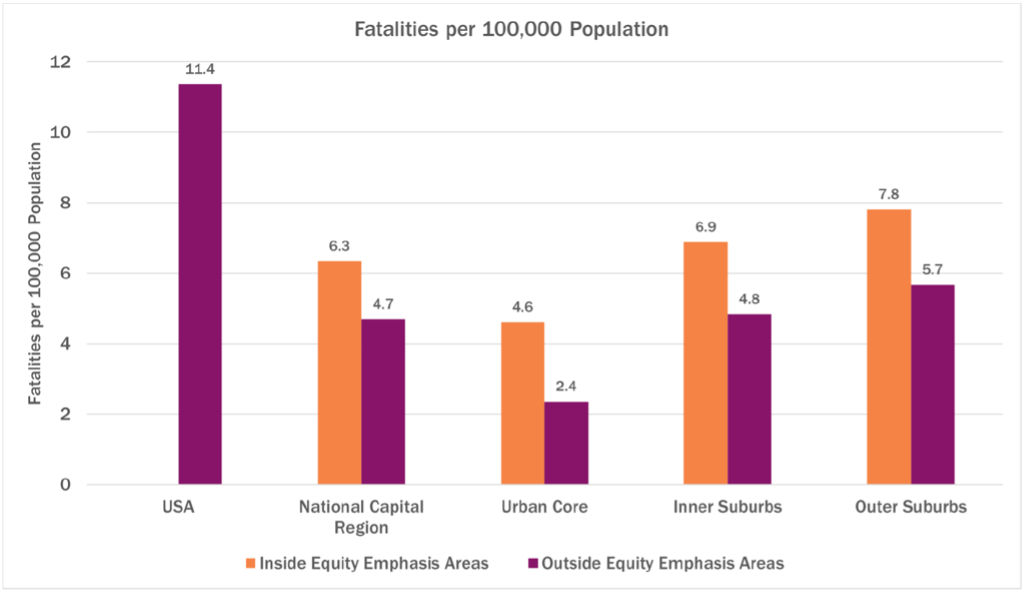Less than a year after being endorsed by the COG Board of Directors and incorporated into Region United: Metropolitan Washington Planning Framework for 2030, Equity Emphasis Areas (EEAs) are becoming part of the region’s planning vocabulary.
EEAs are census tracts with high concentrations of traditionally underserved communities, such as low-income individuals and/or traditionally disadvantaged racial and ethnic population groups. While revealing a regional East-West divide of more tracts located on the Eastern side of the region, EEAs are present regionwide. They are home to 27 percent of the region’s population and have a higher share of households who rent, individuals with disabilities, and workers without a teleworking option.
Originally developed by the Transportation Planning Board (TPB) at COG for analyzing impacts of its long-range transportation plan, EEAs are now being used in a variety of ways to help inform decision-making and elevate equity across the region.
Guiding funding, analytical work at COG
COG committees and staff have been working to understand how EEAs can be used to tie equity goals to specific geographic areas, quantify key needs in our communities, and develop metrics to assess progress.
At the May meeting of the Board of Directors, COG planners provided an overview of how EEAs are being applied in various planning areas, including climate and energy, public health, and roadway safety.
During the development of COG’s 2030 Climate and Energy Action Plan, Senior Environmental Planner Leah Boggs said that EEAs were used to analyze the location of various environmental impacts such as extreme heat as well as flooding and sea level rise. Staff found that residents who live within an EEA are more heavily burdened by extreme heat due to lack of access to air conditioning or resources during power outages.
Through a regional roadway safety study, Transportation Planner Jon Schermann said staff analyzed crash data comparing roadway safety outcomes within EEAs to those outside of these locations. The analysis revealed that the number of roadway fatalities within EEAs was significantly higher than those not in these areas.

As a result of this work, staff made EEAs part of the scoring criteria for the TPB’s Regional Roadway Safety Program, which provides funding for local projects that have the potential to improve safety on the region’s roadways. Of the 14 projects awarded to date, 10 are at locations that are either within or adjacent to EEAs.
Several other COG and TPB grant and technical assistance programs—the Housing Affordability Planning Program, the Transportation Land-Use Connections Program, and the Enhanced Mobility Program, which serves older adults and persons with disabilities—are also using EEAs to inform the project selection process and ensure that the needs of these underserved communities are being met.
Prior to the broader application of EEAs, Principal Health Planner Jennifer Schitter said the COG Health Officials Committee commissioned a study that examined data at the census tract level and revealed that health disparities and inequities in housing, jobs, and education overlap geographically across the region. The study, Uneven Opportunities: How Conditions for Wellness Vary Across the Metropolitan Washington Region, mapped areas of disadvantage to better inform public health planners and policy-makers on strategies to address inequities. Officials are now considering opportunities to build on this work using EEAs for future regional health analyses.
Informing area jurisdictions, partner organizations
During recent COG Board meetings, area leaders from different sectors have shared their experiences applying EEAs in their work. For example, Montgomery County Councilmember Nancy Navarro discussed in June how Maryland’s largest jurisdiction has adopted Equity Emphasis Areas to inform several planning and investment decisions. Navarro pointed to a resolution, which she spearheaded and was unanimously approved in November 2021, calling on Montgomery County to support EEAs as “a key planning concept and tool to inform decision making and action.”
Montgomery County prioritizes projects serving EEAs in its Capital Improvement Program budget. Its recent Green Bank legislation dedicates 20 percent of the institution’s funding allocation to these priority locations. In addition, EEAs have influenced transit access planning related to the Purple Line as well as snow removal requirements to increase pedestrian safety in these locations.
Also in June, the Greater Washington Community Foundation’s President and CEO Tonia Wellons outlined her organization’s work to close the region’s racial wealth gap and talked about how EEAs have informed their focus on local neighborhoods and priority areas.
Another notable planning effort featuring EEAs is Metro’s new 10-Year Strategic Plan for Joint Development. In a presentation to the COG Board in May, Metro Vice President of Real Estate and Parking Liz Price said the plan calls attention to the fact that 70 percent of future developments on Metro-owned land will be in EEAs, highlighting Metro’s commitment to equitable, transit-oriented development.
Updating the EEAs
At the July meeting of the Transportation Planning Board, staff briefed officials on an update to the EEAs tool that reflects the latest data available from the Census Bureau. It was noted that the update did not change the established methodology used to designate EEAs and that there was no significant change in the overall distribution of EEAs in the region since the tool was last updated.
Based on the latest data, 364 Census tracts qualify as EEAs. The share of tracts in the region identified as EEAs has remained at around 27 percent of tracts in the region. Staff will use the new EEAs tool to conduct an environmental justice analysis of the recently adopted update to the Visualize 2045 long-range plan.
An updated, interactive EEAs map has been posted on the COG website. The previous version of the map will be accessible to member jurisdictions in the TPB’s Regional Transportation Database Clearinghouse.
MORE:
Equity Emphasis Areas map - 2022 update
Montgomery County uses COG tool to advance equity in underserved neighborhoods (Washington Business Journal)